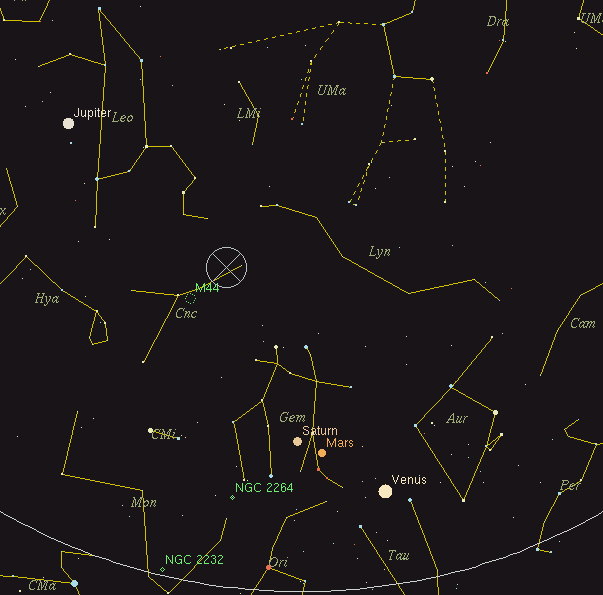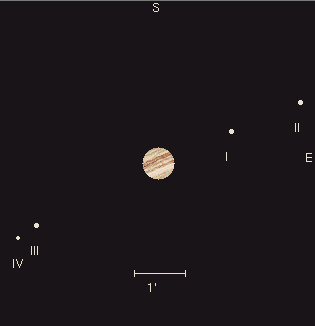
You can find this page on the Internet at
http://spiff.rit.edu/richmond/ritobs/public/may17_2004/may17_2004.html
Tonight, we look for a comet! Comet C/2001 Q4 (NEAT) was discovered by the Near Earth Asteroid Tracking project several years ago. It was farther from the Sun than Jupiter when first noticed back in 2001, but as it has come closer and closer to the Sun, it has been getting brighter. Tonight and for the next couple of weeks, it is bright enough to be seen with the naked eye -- if you know where to look.
If you look to the western sky soon after sunset, you should see the regular pattern of stars and constellations, plus two very bright planets (Venus and Jupiter) and two fainter ones (Mars and Saturn):

If you wait until the sky grows dark, and look very carefully about halfway from Saturn to Jupiter, you should be able to see two faint, fuzzy items. One is a cluster of stars called "M44" or "The Beehive", which lies in the constellation Cancer. The other, just a bit to the North of M44, is Comet C/2001 Q4, which I'll call "Comet NEAT" for short.

The comet is about magnitude 3, which means that if you were to squish all its light into a tiny little point, it would be about as bright as the nearby stars in Cancer. However, the comet's light is spread out into a diffuse coma and a short tail. That makes it appear fainter to the unaided eye. If you were to use a pair of binoculars or a telescope, though, you could make out these features clearly.
This is a photograph of the comet taken on May 8. You won't see nearly as much detail when you look through our telescopes, alas -- the human eye can't integrate light from faint objects in the same way as photographic film or a CCD detector.

Image copyright Chris Schur
Just how much detail can YOU see?
The comet isn't the only target for us tonight. Two of the visible planets have moons we can see with our telescopes. All of Jupiter's Galilean satellites are easy to see. Saturn's moon Titan (VI) is bright at mag 8.4, but Rhea (V) is hard to see at 9.8, and Dione (IV) and Tethys (III) are fainter still, at 10.3. If you can see Iapetus (VIII), you have very sharp eyes: it is mag 11.2 tonight.


There are some satellites of Earth for us to view tonight, too. I took the following information from the Heavens Above satellite prediction site.
A dramatically bright Iridium flare will occur at 9:09 PM!

Other satellites will make longer but dimmer appearances throughout the evening:
